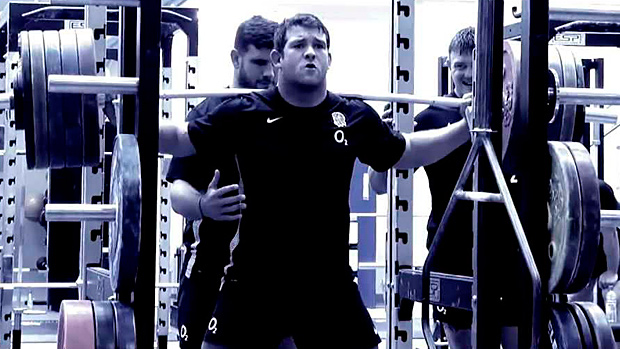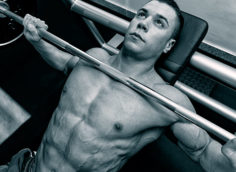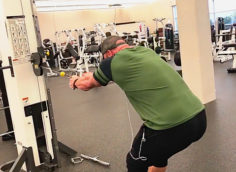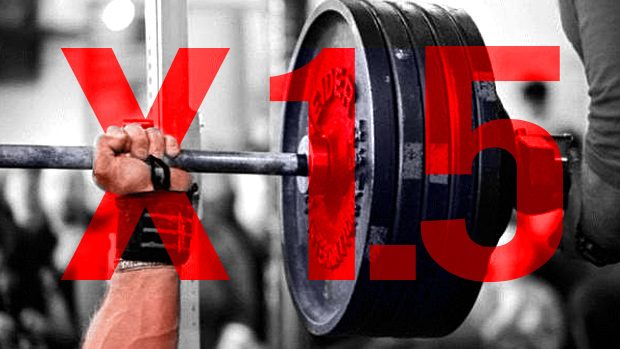How to Build a Freaky Athlete
Since I started writing for T-Nation, I've received literally thousands of e-mails asking me to describe how I set up strength training programs for my athletes. I'm not a big fan of setting up cookie-cutter routines; I like to give people options so they can manipulate a program and then milk it for all it's worth. This article is going to give you a basic off-season template and the options necessary to build freaky athletes.
I'm sure some of you are thinking, "What the hell do I care about athletes? I'm a bodybuilder!" Well, I think bodybuilders could get a huge boost in their training from switching things up and trying something new. Get yourself away from the traditional bodybuilding split of hitting each muscle group once per week, year-in and year-out. It's becoming outdated!
Before I give you the template, I want to go over the four things I really try to emphasize in all my programs. Keep in mind that everything is dependent upon the individual athlete, but these are the four things that I feel most traditional strength programs tend to neglect. Some of it may sound elementary, but the fact of the matter is that most athletes I work with need help in at least one (if not all) of these areas.
1 – Development of the Posterior Chain
The posterior chain is extremely important when looking to improve athletic performance. The calves, hamstrings, gluteals and spinal erectors are all vitally important. Whether you want to jump higher, sprint faster or simply move more weight, you better get to work on developing a strong P-Chain!
2 – Unilateral Work
I'm all for bilateral (two limb) strength work, but a lot of old school strength programs focus solely on bilateral strength work. Don't worry, all variations of squats, deads, RDL's and good mornings can be employed. I'm the first to tell you that all these should be the bread-and-butter of your strength program, but you also need to include single-leg (unilateral) work to maximize performance. I'm always impressed when I see a big fella squat six or seven hundred pounds, but it's no good if he can't use that strength on the field or court!
The truth is that most sports are played with one leg producing force at a time, so the need for unilateral work in the strength program can't be neglected. Single-leg work is also important for developing several muscles/muscle groups that normally tend to get neglected in traditional strength training programs. A few of these include the VMO, glutes and adductors.
3 – Injury Prevention
Simply put, it's hard to make progress in the gym or on the field if you're injured! With that in mind, I put a fair amount of work into keeping the body healthy. The entire program puts an emphasis on strength, but it also puts in special work for often-injured areas such as the shoulders, knees, ankles, wrists, etc.
Try to keep in mind here that this is a general template; certain sports predispose certain muscle groups to an increased injury rate. For example, most swimmers are very strong and tight in the pectorals and shoulders, so prehab/injury prevention work would incorporate strength training for the scapular retractors, scapular depressors and external rotators. As an adjunct to this strength training, we'd also incorporate stretching exercises for the pecs, lats and internal rotators of the shoulder.
4 – Development of Flexibility and Strength Around the Hips
The hips are the foundation of almost every great athlete, but strength and flexibility are both crucial! Whether you want to jump higher, sprint faster or just squat and deadlift more weight, you need a balance of strength and flexibility in your hip muscles.
The Template
Below is the general template I use for my athletes. Keep in mind this is a general template! Every athlete is going to have individual needs dependent upon their prior training, sport they play, injury history, etc. However, this should give you a pretty good idea of how you can arrange and organize a training program that will increase performance both in the weight room and on the field.
| Day 1 Low Body |
Day 2 Upper Body |
Day 3 Low Body 2 |
Day 4 Upper Body 2 |
|---|---|---|---|
| Heavy Squat | Heavy Bench | Heavy Pull | Heavy Vertical Pull |
| Heavy Posterior Chain | Heavy Row | Heavy Posterior Chain | Single Arm Horizontal Push |
| Single Leg | Vertical Push | Single Leg | Accessory Horizontal Pull |
| Accessory Posterior Chain | Triceps Push | Accessory Post Chain | Triceps Extension |
| Calf/Dorsiflexion | Biceps | Ankle Work | Forearm Work |
| Glute Activation Circuit | Scap Circuit | Glute Activation Circuit | External Rotation Circuit |
I like to use an M-T-Th-F setup throughout the week. This gives you plenty of recovery time and also allows the athlete to enjoy his or her weekends. I want my kids to be stud athletes, but I want them to have a life outside of sport as well.
Exercise Choices
Now that you have the template, let's give you examples of the exercises. This isn't an all-encompassing list, but it should give you an idea of what exercises fall into each individual group.
You'll also notice that some exercises are placed into more than one category. This is due to the fact that they can be used for different purposes by altering the loading, sets and reps, rest period, etc. A good example would be reverse hypers. You can use them in the bilateral posterior chain category for lower reps per set, thus making them primarily a strength builder. However, the exercise could also be used in the accessory posterior chain category with higher reps per set, making reverse hypers more effective for building a mix of strength and hypertrophy in the posterior chain.
Monday
- Heavy Squat: Power, front, Olympic, box, safety bar
- Sets and Reps: 3-5 sets of 5-10 repetitions
The squat is arguably the best developer of strength and power in the lower body; for that reason, I often use it first in the training week. You'll also note that while I use box squats, they aren't the only squat I'll use when developing my athletes. The box squat is excellent for improving the squat and the posterior chain, but many sports activities utilize all the leg and hip muscles! For instance, the quadriceps are very important in the vertical jump, so I use all forms of squatting to develop maximal strength in the legs and hips. Don't worry, we'll have plenty of P-Chain fun later on!
- Heavy Posterior Chain: RDL's (Romanian Deadlifts), Good Mornings, Safety Bar Good Mornings, Reverse Hypers
- Sets and Reps: 2-4 sets of 6-8 repetitions

I've divided up the posterior chain exercises into two separate categories: heavy and accessory. The primary difference is the loading used. The heavy group lends itself to big weights and maximal strength development while the accessory group lends itself to higher reps and a mix of strength and hypertrophy. The heavy group is comprised of bilateral exercises that'll strengthen the glutes, hamstrings and spinal erectors to a high degree.
- Single-Leg: Lunges, Bulgarian Squats, Single-Leg Squats, Step-ups, Step-downs, King Deadlifts, RDL's
- Sets and Reps: 2-4 sets of 5-10 repetitions each leg
If you want a thorough description of single leg exercises, check out my Single-Leg Supplements article. Remember, not only are these exercises great developers of the entire leg, but most sports movements are performed with only one leg at a time producing force.
- Accessory Posterior Chain: Glute Ham Raise, Pull-Throughs, Reverse Hypers, Dumbbell RDL's
- Sets and Reps: 3-5 sets of 6-12 repetitions

As if your posterior chain wasn't already on fire, we finish it off here with more strength and hypertrophy work. The exercises in this category are great developers of the posterior chain, but most of them aren't good choices if you want to crank up the weight. For this reason alone, I typically put them further down in the workout. Keep in mind that you can use bilateral or unilateral exercises in this part of your workout.
- Calf Exercises: Standing Calf Raise, Seated Calf Raise, Single-leg Calf Raise
- Dorsiflexion Exercises: Dumbbell Dorsiflexion, DARD Dorsiflexion, Partner Resisted Dorsiflexion
- 2-3 sets of 8-20 repetitions

This section should be fairly straightforward. Most athletes can simply skip the dorsiflexion exercises; however, if you have a history of getting shin splints, some serious postural dysfunction, or participate in a sport where shin splints are prevalent (especially distance running), this may be something you want to include.
- Glute Activation Work: Floor Bridge, Single-leg Bridge, Glute Walks, Birddog
- Sets and Reps: 2-3 sets of 8-12 repetitions

These are some basic motor control exercises to ensure that the gluteals are working properly. Please refer to the "Neanderthal No More" article series in the archives if you'd like pictures and descriptions of these exercises. I generally have the athletes pick two exercises and perform them in circuit fashion.
Tuesday
- Heavy Bench: Barbell Bench, Incline, Decline, Flat Dumbell, Dumbell Incline, Dumbell Decline, Dumbell Stability Ball Press, Floor Press, Board Press
- Sets and Reps: 3-5 sets of 3-8 repetitions
For all you bench monsters out there, this is your time to shine! The bench press (and all variations) is the primary developer of the horizontal pushing muscles in the upper body. I like to use a wide variety of exercises here rather than force my athletes to perform the barbell bench press week-in and week-out. All of these different variations have different benefits. Partial movements let you get heavy loads in your hands and produce brute strength, while dumbbells develop strength through an increased ROM (range of motion).
- Heavy Row: Bent-over, Seated Cable Row, Dumbell Row
- Sets and Reps: 4-6 set of 6-10 repetitions
A heavy row is typically included immediately following the bench. Remember, all upper body pulling exercises were not created equal! Heavy rows are a must if you value the long-term stability of your shoulders. Beyond simply working to develop muscle balance, rows are an often forgotten back exercise that can slap some serious muscle on your bones.
I like to do more hypertrophy related work (especially in the off-season) to increase muscle mass; beyond that, it seems that too often people start piling on the heavy weights and their form goes down the tubes. Remember to pull through your elbows, squeeze at the midpoint, and relax/stretch the arms at the start and finish.
- Vertical Push: Standing Military, Seated Military, Bradford Press, Push Press, Single-Arm Military
- Sets and Reps: 2-3 sets of 6-10 repetitions
The deltoids (particularly the anterior head) are often overtrained simply due to all the horizontal pressing that occurs in most strength programs. For that reason, I typically only use one overhead pressing exercise per week. Beyond that, it's very rare that you ever have to push a defender off the top of your head! The application to sporting movement is minimal, but I still include some overhead pressing simply to maintain muscle balance around the shoulders.
- Triceps Push: Close Grip Bench, Close Grip Incline, Close Grip Decline, Dips
- Sets and Reps: 3-5 sets of 5-10 repetitions

While the heavy bench is the primary developer of maximal horizontal pushing strength in the upper body, I think that the triceps push movements are often more similar to actions seen on the playing field. For example, you wouldn't move your hands out wide to stiff-arm an opponent; you'd keep it in close and tight to the body. This is the same with a lineman coming out of a stance: his hands are in tight and coming in low on the chest. Strengthening the triceps to a high degree is essential in many sporting movements.
- Scap Circuit: Scapular Wall Slides, Prone Lower Trap Raises, Prone Cobras
- Sets and Reps: 2-3 sets of 8-15 repetitions

This is the prehab section of this upper body workout. Our goal is to further strengthen and recruit the rhomboids and middle/lower trapezium to injury-proof the shoulder. I'll generally prescribe two to three exercises performed in a circuit fashion. Make sure that the movement is with the scapular muscles versus the hands or arms! Momentum isn't our friend in this case; we want the proper muscles to work at this time. Remember, quality over quantity!
- Biceps: You choose
- Sets and Reps: You choose
Let's be honest here, the only things the biceps are important for in most sports are looking good for your team pics and knocking back a few cold ones after a victory! With that in mind, I'll let you choose your own biceps exercises. Just don't overdo it.
Thursday
- Heavy Pull: Deadlift (conventional, Sumo, snatch-grip, Romanian, trap bar), Rack pull, High pull from floor
- Sets and Reps: 3-5 sets of 3-6 reps
Most traditional strength programs place an inordinate amount of work toward developing the squat, while at the same time placing minimal emphasis on pulling exercises. This is bad for several reasons:
- Pulls are an excellent developer of the P-Chain.
- Squat based programs (with little or no emphasis on pulls or posterior chain work) leave the knees at an increased risk of injury.
- Pulls are an excellent way to get stronger overall and put slabs of muscle on your body!
So if you aren't already putting a heavy emphasis on pulls, I won't chastise you as long as you start immediately! I typically use lower reps per set, simply because there's a heavy emphasis on lower back strength and endurance. Using improper or downright bad technique can get you injured, so I'd rather train this in a lower rep range where the athlete can focus on using heavy weights while still performing each rep with the eloquence of a Beethoven symphony.
- Heavy Posterior Chain: Same choices as Monday, but use a different exercise
This exercise is selected from the same group as Monday, but I like my athletes to choose a different exercise and therefore get a different stimulus. For example, you might choose RDL's on Monday, and then perform safety bar, concentric-only good mornings on this day.
The key is to always be changing the exercises and figure out which ones your body derives the most benefit from. Beyond that, you want to enjoy training. Not only will you train harder, but you'll be a lot less likely to burn out in the long run.
- Single Leg: Same choices as Monday, but use a different exercise
Same deal as before, but again pick a different exercise. I'll often use a basic variation on Monday's workout and then on Thursday I'll use an enhanced ROM exercise when acceptable. For instance, a program might look like this:
- Monday: Dumbbell Lunges (basic movement)
- Thursday: Bulgarian Squats on 6" Box (enhanced ROM variation)
This increased ROM would even further recruit the VMO and glutes. Our goal with these single-leg exercises is to balance the legs and make your knees virtually indestructible. Do this for four weeks, and then on the next phase you can alternate between a glute/VMO based single-leg exercise and a more posterior chain dominant single-leg exercise. Below is an example:
- Monday: Single-leg squat (traditional movement)
- Thursday: Single-leg RDL (posterior chain dominant)
This way you're developing the entire leg musculature and injury-proofing the body all at the same time!
- Accessory Posterior Chain: Same choices as Monday, but use a different exercise
Same ol', same ol' here. Different day, different exercise. This is the time to experiment with new exercises and see if they'll be included more often or discarded. If you're going to use the same exercise, make sure to switch up the sets, reps, rest periods and load to keep your body adapting.
- Ankle Work: Partner Resisted Inversion/Eversion, Ankle Walks
- Sets and Reps: 2-3 sets of 12-15 repetitions
Strengthening the muscles, tendons and ligaments that make up the ankle joint is just downright smart injury-prevention work in my book. I remember reading that in his heyday, Michael Jordan used to perform tons of prehab work for the ankles. This way, even if he did sprain an ankle, it could reduce the severity from a Grade 3 sprain to a Grade 1, simply because his soft-tissue was strong enough to prevent an even worse injury. This might not sound like a lot, but the difference could be between missing a week and missing a month or more. What's an extra ten minutes if it keeps you in the game, right?
Friday
- Heavy Vertical Pull: Chin-ups, Pull-ups, Towel Pull-ups, Lat Pulldowns
- Sets and Reps: 4-5 sets of 6-8 repetitions
When most people think of back work, they think of chin-ups and pulldowns, but rarely do they think of rowing movements. We worked on rowing movements earlier in the week, so today will be the primary developer of the vertical pulling muscles. While most athletes are totally under-developed in rowing movements, most of their vertical pulling movements aren't that great either.
I like to use a simple progression with my athletes, depending on their strength levels. If they're even close to doing chins, they'll be doing chins soon! There's no greater developer of vertical pulling strength than chin-ups and pull-ups, so here's the progression I use to get them there:
Pulldown Progression: Close grip, supinated pulldown → Wide grip, supinated pulldown → Medium grip, pronated pulldown → Wide grip, pronated pulldown
Once they're strong enough to do a sufficient number of reps with close to bodyweight, I then start them in on the chins, using the same progression:
Chin/Pull-up Progression: Close grip chins → Wide grip chins → Medium grip pull-ups → Wide-grip pull-ups
As you can see, we're working from a position of the most biomechanical advantage (close-grip and supinated) to the position of least mechanical advantage (wide-grip and pronated). Take the time necessary to develop these muscles and you won't be sorry!
- Single Arm Horizontal Push: Dumbell Bench, Dumbell Incline, Dumbell Decline, Dumbell Stability Ball Press, Dumbell Floor Press
- Sets and Reps: 3-4 sets of 5-8 repetitions
On this day I like to use some balancing work for the horizontal pressing muscles. If you've ever spotted a significant number of athletes, you'll notice that more than a few "windmill" the bar up or press up unevenly. This is a tell-tale sign that there are some right-to-left strength imbalances. Dumbbells are necessary here, and you can perform either traditional dumbbell pressing or you can alternate arms.
To perform this, hold your left arm at lockout while your right arm goes through the ROM. As the left arm returns to the top, hold it at lockout while the right arm goes through the ROM. This variation may take a while to get used to, but it will help iron-out strength imbalances between the pressing muscles.
- Accessory Horizontal Pull: Rope Pulls, Dumbell Rows, Single Arm Cable Rows
- Sets and Reps: 3-4 sets of 6-10 repetitions
The goal here is to put on some added muscle mass in the upper back. Strengthening the rhomboids and mid/lower trapezium can help prevent a myriad of shoulder injuries, so I always add in extra upper back work when possible. Beyond that, most programs are so heavily geared towards driving up the bench press poundage that they neglect the upper back. If one of my athletes gets injured, it better be from some freak accident on the field, not poor planning and training in the weight room!
- Triceps Extension: Skull Crushers, Throat Crushers, Dumbell Skull Crushers, Triceps Pushdown, Band Pushdown
- Sets and Reps: 3-4 sets of 6-12 repetitions

Here (like the accessory posterior chain and horizontal pull) we're trying to add a mix of strength and hypertrophy to the triceps. Not too much to think about here.
- Forearm Work: Wrist Flexion, Wrist Extension, Pronation/Supination, Grippers, Fat-bar exercises
- Sets and Reps: You choose!
I might be opening up a can of worms by allowing you to choose your own sets and reps, but the truth is that this is totally dependent upon what exercises you're doing, your current training level, etc. I'd suggest just doing two or three sets of two to three exercises in a circuit fashion. These muscles aren't going to make or break your athletic performance in most sports, but if you've ever had to rehabilitate a wrist injury you'll thank me for adding in this little bit of prehab work!
- External Rotation Work: Muscle Snatch, Shoulder Horn, Poor Man's Shoulder Horn, Low Pulley External Rotation
- Sets and Reps: 3-4 sets of 8-15 repetitions

In the off-season I prefer using higher sets and reps, focusing on developing proper motor control and recruitment patterns in the external rotators. The increased sets and reps will also lead to some hypertrophy of this often under-trained (or totally un-trained!) muscle group.
The Million Dollar Question
Do you use Olympic lifts? If so, where do you put them?
First off, yes, I do use Olympic lifts in my programs. I feel if you want to improve your power producing capabilities in the weight room, these lifts are second to none. If you're interested in using the template I outlined above, I always place any explosive lifts first and foremost in the training day, and typically I use them on lower body days.
For instance, on Monday I'd perform power snatches from above the knee, and then move on to the squat movement. I'd also take off one of the posterior chain exercises outlined for the day. If you're performing the Olympic lifts correctly, you'll still be getting plenty of posterior chain work with the added benefit of that work being high velocity/high tension work that's more applicable to most sporting movements.
So how does this change affect the rest of the template? If you're laying out the weekly cycle, you still want to have a heavy posterior chain exercise and an accessory posterior chain exercise. So on Monday you might take out the heavy bilateral posterior chain exercise, and then on Thursday you might take out the accessory posterior chain exercise. That way you're still getting the benefits of both types of exercises within the training week.
Conclusion
Hopefully I've shed some light on how I set up training programs for my athletes. I use bits and pieces from tons of different sources to come up with what I consider a somewhat unique training system. Keep in mind that this is just a basic, off-season plan. I use lots of more advanced training techniques as the athlete progresses in chronological and training age, but this is a great foundation for those trying to get stronger and improve their performance on the field.
Give this program a try and don't be surprised to find yourself resembling a super studly athlete in just a few weeks!




